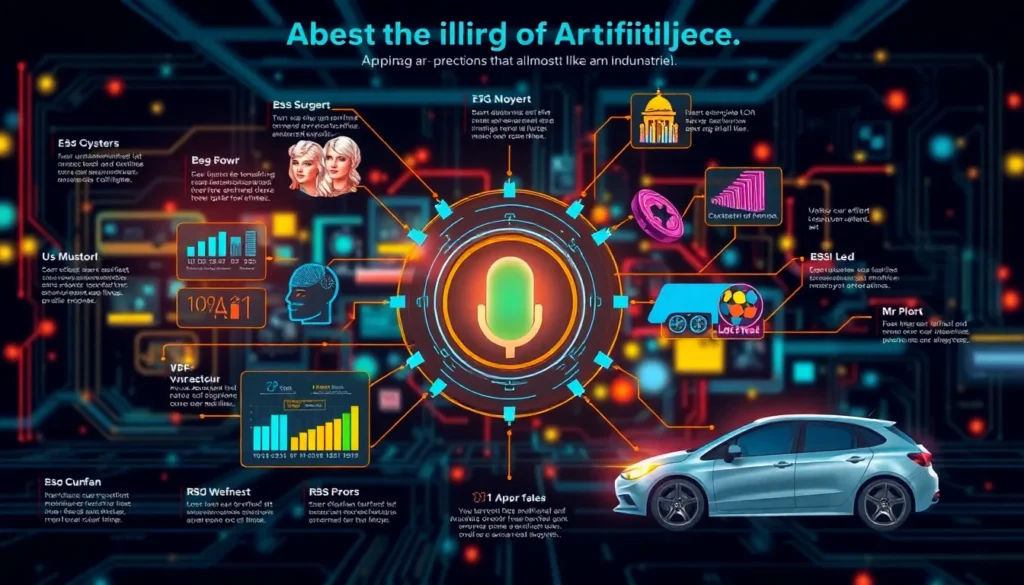Artificial intelligence is no longer just a buzzword tossed around at tech conferences. It’s the powerhouse behind everything from voice assistants to self-driving cars, and it’s revolutionizing industries faster than you can say “machine learning.” But how does one wrap their head around such a complex topic? Enter the artificial intelligence infographic—a visual feast that makes understanding AI as easy as pie (and just as satisfying).
Table of Contents
ToggleOverview Of Artificial Intelligence Infographics
Artificial intelligence infographics serve as visual representations of complex AI concepts. They simplify intricate data and enhance understanding through visuals. Various elements within these infographics include statistics, charts, and illustrations that present relevant findings in a digestible format.
Understanding AI applications is crucial. Infographics can showcase the utilization of AI in industries such as healthcare, finance, and transportation. They facilitate quick insights into topics like machine learning algorithms and natural language processing. Each section of an infographic can focus on a specific aspect, making it easier for readers to grasp essential information.
Creativity plays a significant role in designing effective infographics. Designers use color schemes and layout techniques to capture attention while maintaining clarity. Infographics often incorporate engaging visuals like icons and images to reinforce messages. Those visuals not only attract viewers but also aid retention of information presented.
Interactivity adds another layer to the traditional infographic experience. Some AI infographics feature interactive elements that allow users to explore data dynamically. This engagement promotes deeper learning as users interact with the content.
Purposefully crafted infographics become valuable educational tools. They appeal to a broad audience, including students, professionals, and enthusiasts. When presented effectively, artificial intelligence infographics foster a better understanding of AI’s potential and challenges.
Benefits Of Using Infographics In AI

Infographics play a vital role in enhancing the understanding of AI concepts. They transform complex information into visually appealing formats that engage a wide range of audiences.
Visual Communication
Visual communication boosts comprehension significantly. Infographics present AI data using colors, images, and symbols that resonate with viewers. Designers can convey messages quickly and effectively, reducing the time needed to grasp intricate topics. For instance, an infographic illustrating AI’s impact on healthcare can capture attention and highlight crucial statistics at a glance. Such visuals encourage sharing, expanding the reach of valuable information to diverse audiences. Engaging visuals foster an inviting atmosphere for learning, making challenging subjects like AI more relatable.
Simplified Data Representation
Simplified data representation enhances clarity. Infographics focus on essential metrics and concepts, stripping away excess jargon. Well-designed visuals organize statistics into charts and graphs, allowing viewers to interpret information quickly. For example, a bar chart comparing applications in various sectors reveals trends and differences instantly. Readers grasp complex AI functionalities more effectively through neatly presented data. Concise infographics lead to better retention, ensuring users can recall important details long after first viewing the material. In this manner, infographics serve as pivotal tools in demystifying artificial intelligence for everyone.
Key Components Of An Effective AI Infographic
An effective AI infographic combines visual appeal with informative content. Attention to key design elements enhances comprehension and retention.
Use Of Color And Design
Color choices influence viewer engagement. Color schemes should align with the infographic’s subject matter, creating a cohesive look. Contrasting colors can highlight key information, making essential data stand out. Consistent design elements, such as fonts and layout, contribute to visual harmony. Visual hierarchy guides viewers, directing their eyes towards the most important aspects. Incorporating icons and illustrations adds appeal, capturing interest and breaking up text-heavy sections. Creativity in design plays a crucial role in making the infographic memorable. Engaging visuals draw attention, encouraging users to explore the content further.
Clarity And Conciseness
Clarity remains vital for effective communication. Information should be presented in simple, straightforward language, ensuring it is accessible to all audiences. Limit complex jargon to avoid confusion. Conciseness aids in retaining viewer attention; each piece of information should serve a purpose. Organize data into easily digestible formats, such as bullet points or short paragraphs. Focus on essential statistics and salient points to maintain clarity. Clear graphics complement the text, reinforcing understanding without overcrowding the viewer’s mind. Effective infographics summarize key ideas succinctly while encouraging deeper exploration of the topic.
Examples Of Notable AI Infographics
Several effective AI infographics stand out for their ability to convey complex information clearly. One prominent example is the “AI in Healthcare” infographic, which illustrates how AI tools enhance diagnostics and treatment. Detailed statistics about AI’s impact on patient outcomes provide valuable insights into its role in the medical field.
The “Future of AI in Finance” infographic demonstrates specific AI applications such as fraud detection and algorithmic trading. This visual representation breaks down data about financial improvements achieved through AI, making the information more digestible for industry professionals. It also highlights statistics that show how AI technology can optimize operational efficiency.
Another remarkable example is the “AI and Transportation” infographic. It outlines the advancements in autonomous vehicles and intelligent traffic management systems. By presenting statistics on accident reduction and travel time efficiency, this infographic emphasizes the transformative potential of AI in this sector.
The “AI Across Industries” infographic offers a broad overview of AI applications in various sectors. It categorizes industries such as education, agriculture, and entertainment, showcasing relevant statistics for each. This presentation aids readers in understanding the widespread adoption of AI technology.
Lastly, the infographic titled “The Evolution of AI” provides a timeline showcasing key milestones in AI development. It features significant technological advancements and pivotal research breakthroughs, making the historical context of AI more accessible. This engaging format captivates the audience while educating them about AI’s journey.
These examples illustrate how impactful infographics can transform knowledge of AI into visual formats. Their clarity enhances understanding and encourages further exploration of artificial intelligence across diverse fields.
Artificial intelligence infographics play a crucial role in demystifying complex concepts and making information more accessible. By transforming intricate data into engaging visuals they not only enhance understanding but also facilitate retention. The thoughtful design elements such as color schemes and interactive features elevate the learning experience.
These infographics serve as powerful educational tools across various industries highlighting AI’s potential and challenges. As the demand for clarity in information grows the importance of well-crafted infographics will continue to rise. Embracing this visual communication method can foster deeper exploration and appreciation of artificial intelligence in today’s rapidly evolving landscape.

